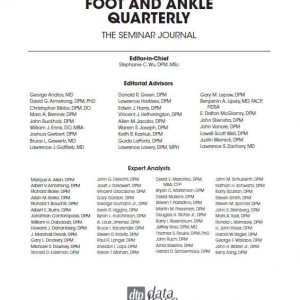32-2 Cutaneous Lesions
$88.00
Editorial
What a great honor and privilege it is to welcome you once again all to an issue of FAQ that is as timely as it is important. I am secure that with the elite quality of our multidisciplinary reviewers, you will totally enjoy and digest their perspectives on articles that represent these interesting times in the fields of both podiatric medicine and dermatology.
It is highly imperative that the foot and ankle physician be cognizant of the many (sometimes exotic) cutaneous conditions which attack our realm. Thus, it’s important to remember: diagnosis first, and biopsy if needed (even more so with uncommon conditions that mandate a higher index of suspicion – some of which are explored in this issue). These lesions at times necessitate uncommon methods of treatment modalities, and improving one’s skills and diagnostic acumen will certainly lead to increased confidence in managing these difficult but intriguing disorders. Most importantly, it will give our footsore patients better outcomes, as good results and fortunes often favor the well-prepared.
I would like to thank all who contributed to this team personally – each and every one is a true expert, and their efforts, collaboration and dedication to this issue have more than fulfilled my goal of providing relevant clinical pearls to add to each reader’s treatment toolbox. In particular, I’d like to thank my friends and colleagues Drs. Bret Ribotsky and William Scherer for their work on the unique “roundtable” approach to our lecture on Practical Chair-Side Dermatology, as well as our rising star Dr. Ebonie Vincent as she explores in her lecture the rare but fascinating Treeman syndrome. I would also like to offer special thanks to Camryn Vader, an internationally-recognized Grand Challenge Scholar who brings to the mix her unique perspective as an active student in Neuroscience and Public Health.
Those of us who are in the trenches each and every day strive to synthesize the mass of material that comes to us in lectures, journals, websites, email, and even text messages. Hopefully, the insights gained from this issue will facilitate a greater understanding of the cutaneous states, and as such will improve our skills to make the correct diagnoses and select the best treatment options for our patients.
Marc A. Brenner, DPM
Description
In This Issue:
- FEATURE ARTICLE: In the Hunt for Ectodermal Dysplasia: A Review Article
Marc A. Brenner, DPM and Albert Raminfard, DO - CONDENSATIONS and COMMENTARIES
- Pernio-Like Skin Lesions Associated with COVID-19: A Case Series of 318 Patients from Eight Countries
Commentary by Michael S. Nirenberg, DPM - Sole-Searing Pain: Classic Kaposi’s Sarcoma
Commentary by Annette Joyce, DPM - A Survey Study with Assessment of Esophageal Screening and Genetic Counseling in Patients with Howel-Evans Syndrome
Commentary by Elizabeth M. Bonarigo, DPM - Proteus Syndrome of the Foot: A Case Report and Literature Review
Commentary by Lawrence B. Harkless, DPM - Trends and Histopathological Patterns of Kaposi’s Sarcoma at the University of Benin Teaching Hospital, Benin City, Nigeria
Commentary by Camryn Vader, Steve McClain, MD and Kim Rhatigan, MA - Treatment of Feet Deformities in Epidermolysis Bullosa
Commentary by Michael J. Trepal, DPM - Hereditary Palmoplantar Keratoderma: A Practical Approach to the Diagnosis
Commentary by G. Javier Cavazos, Jr., DPM - Diagnosis and Management of Acral Lentiginous Melanoma
Commentary by Laura Shin, DPM, PhD - Erosio Interdigitalis Blastomycetica: A Review of Interdigital Candidiasis
Commentary by Byron N. Collier, DPM - Chronic Madura Foot: Mycetoma and/or Actinomyces or Actinomycosis
Commentary by Michael S. Nirenberg, DPM and Pradeep Albert, MD
- Pernio-Like Skin Lesions Associated with COVID-19: A Case Series of 318 Patients from Eight Countries
- AUDIO LECTURE 1: Treeman Syndrome
Ebonie Vincent, DPM - AUDIO LECTURE 2: Practical Chair-Side Dermatology: A Roundtable Discussion
Marc A. Brenner, DPM, Bret M. Ribotsky, DPM and William P. Scherer, DPM, MS - CONTINUING EDUCATION QUESTIONNAIRE


